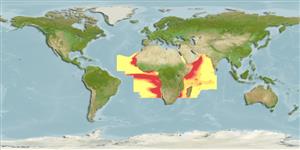Teleostei (teleosts) >
Trachichthyiformes (Roughies) >
Trachichthyidae (Slimeheads)
Etymology: Hoplostethus: Greek, hoplon = weapon + Greek, stetho, stethion = brest; literal = to prick a little breast (Ref. 45335).
Eponymy: Dr Jean Cadenat (1908–1992) of the University of Dakar, was a French researcher and ichthyologist at the ‘Office de la recherche scientifique et technique outre-mer’, where he was Director of the Marine Biological Section of the Institute Français [...] (Ref. 128868), visit book page.
Environment: milieu / climate zone / depth range / distribution range
Ecology
Marine; bathypelagic; depth range 70 - 1000 m (Ref. 9869), usually 200 - 700 m (Ref. 36731). Deep-water; 28°N - 27°S
Eastern Atlantic: along the coast of northwest Africa between 27°30'N to 10°10'N and 1°26'S to 26'14°S. Reported from Cape Verde (Ref. 27000). Western Indian Ocean: off Transkei, South Africa (Ref. 4181).
Size / Weight / Age
Maturity: Lm ? range ? - ? cm
Max length : 30.0 cm TL male/unsexed; (Ref. 3583)
Lives near the bottom in deep water, from 200 to at least 500, but possibly to 1000 m depth. Feeds on crustaceans (Ref. 3695).
Life cycle and mating behavior
Maturity | Reproduction | Spawning | Eggs | Fecundity | Larvae
Maul, G.E., 1990. Trachichthyidae. p. 620-622. In J.C. Quéro, J.C. Hureau, C. Karrer, A. Post and L. Saldanha (eds.) Check-list of the fishes of the eastern tropical Atlantic (CLOFETA). JNICT, Lisbon; SEI, Paris; and UNESCO, Paris. Vol. 2. (Ref. 3583)
IUCN Red List Status (Ref. 130435: Version 2024-1)
Threat to humans
Harmless
Human uses
Fisheries: commercial
Tools
Special reports
Download XML
Internet sources
Estimates based on models
Preferred temperature (Ref.
123201): 6.3 - 15.4, mean 11.1 °C (based on 155 cells).
Phylogenetic diversity index (Ref.
82804): PD
50 = 0.5000 [Uniqueness, from 0.5 = low to 2.0 = high].
Bayesian length-weight: a=0.01660 (0.00714 - 0.03859), b=3.05 (2.85 - 3.25), in cm total length, based on LWR estimates for this (Sub)family-body shape (Ref.
93245).
Trophic level (Ref.
69278): 3.2 ±0.37 se; based on food items.
Resilience (Ref.
120179): Very Low, minimum population doubling time more than 14 years (Preliminary K or Fecundity.).
Fishing Vulnerability (Ref.
59153): Low vulnerability (20 of 100).
Nutrients (Ref.
124155): Calcium = 13.5 [3.6, 68.2] mg/100g; Iron = 0.372 [0.106, 1.261] mg/100g; Protein = 2.38 [0.00, 6.27] %; Omega3 = 0.168 [0.050, 0.591] g/100g; Selenium = 9.36 [2.14, 40.72] μg/100g; VitaminA = 40.2 [4.3, 418.0] μg/100g; Zinc = 0.563 [0.227, 1.476] mg/100g (wet weight);
